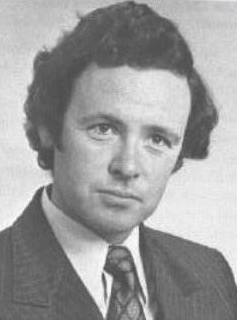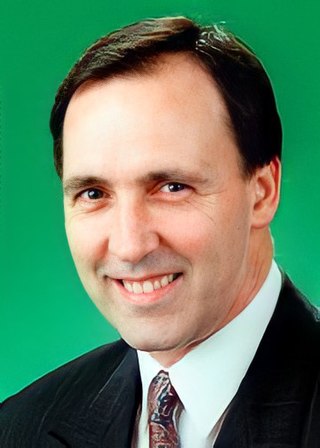
Robert James Lee Hawke was an Australian politician and trade unionist who served as the 23rd prime minister of Australia from 1983 to 1991. He held office as the leader of the Australian Labor Party (ALP), having previously served as the president of the Australian Council of Trade Unions from 1969 to 1980 and president of the Labor Party national executive from 1973 to 1978.

Paul John Keating is an Australian former politician who served as the 24th prime minister of Australia from 1991 to 1996, holding office as the leader of the Australian Labor Party (ALP). He previously served as treasurer under Prime Minister Bob Hawke from 1983 to 1991 and as the seventh deputy prime minister from 1990 to 1991.

Simon Findlay Crean was an Australian politician and trade unionist. He was the leader of the Australian Labor Party (ALP) and leader of the opposition from 2001 to 2003. He represented the seat of Hotham in the House of Representatives from 1990 to 2013 and was a cabinet minister in the Hawke, Keating, Rudd and Gillard governments.

Kim Christian Beazley is an Australian former politician and diplomat. Since 2022 he has served as the Chairman of the Australian War Memorial. Previously, he was leader of the Australian Labor Party (ALP) and leader of the opposition from 1996 to 2001 and 2005 to 2006, having previously been a cabinet minister in the Hawke and Keating governments. After leaving parliament, he served as ambassador to the United States from 2010 to 2016 and 33rd governor of Western Australia from 2018 to 2022.

John Robert Hewson AM is an Australian former politician who served as leader of the Liberal Party from 1990 to 1994. He led the Liberal-National Coalition to defeat at the 1993 Australian federal election.

Ralph Willis AO is an Australian former politician who served as a Cabinet Minister during the entirety of the Hawke-Keating government from 1983 to 1996, most notably as Treasurer of Australia from 1993 to 1996 and briefly in 1991. He also served as Minister for Industrial Relations, Minister for Transport and Communications and Minister for Finance. He represented the Victorian seat of Gellibrand in the House of Representatives from 1972 to 1998.

John Sydney "Joe" DawkinsAO is an Australian former politician who was Treasurer in the Keating Labor government from December 1991 to December 1993. He is notable for his reforms of tertiary education as Minister for Employment, Education and Training, his period as Treasurer when he attempted to increase taxes in order to balance the budget and his abrupt exit from politics.

John Charles Kerin was an Australian economist and Labor Party politician who served in the House of Representatives from 1972 to 1975 and again from 1978 to 1993. He held a number of senior ministerial roles in both the Hawke and Keating governments, including six months as Treasurer of Australia and eight years as Minister for Primary Industries and Energy, holding the latter role for the longest period in Australian history.

The 1990 Australian federal election was held in Australia on 24 March 1990. All 148 seats in the House of Representatives and 40 seats in the 76-member Senate were up for election. The incumbent Australian Labor Party, led by Bob Hawke, defeated the opposition Liberal Party of Australia, led by Andrew Peacock, with its coalition partner, the National Party of Australia, led by Charles Blunt, despite losing the nationwide popular and two-party-preferred vote. The result saw the re-election of the Hawke government for a fourth successive term, the first time the ALP had won four consecutive terms.
The following lists events that happened during 1991 in Australia.
A Kirribilli agreement, in Australian politics, is an agreement, typically confidential, between a leader and their deputy for the handing over of power on the satisfaction of an agreed precondition.

The 1987 Australian federal election was held in Australia on 11 July 1987, following the granting of a double dissolution on 5 June by the Governor-General Sir Ninian Stephen. Consequently, all 148 seats in the House of Representatives as well as all 76 seats in the Senate were up for election. The incumbent Australian Labor Party, led by Prime Minister Bob Hawke, defeated the opposition Liberal Party of Australia, led by John Howard and the National Party of Australia led by Ian Sinclair. This was the first, and to date only, time the Labor Party won a third consecutive election.

Keating! is a sung-through musical which portrays the political career of former Australian Prime Minister Paul Keating. Keating was Prime Minister between 1991 and 1996; the musical follows him from his ascent to the leadership through to his eventual electoral defeat by John Howard. It was written by Casey Bennetto, who was inspired to write the show by his disappointment at the results of the 2004 federal election, which saw Howard's Coalition government returned for a fourth term. The musical takes a humorous, satirical tone and presents a positive image of Keating while frequently criticising the Howard government. Bennetto describes the show as "ridiculously pro-Paul Keating".

The Hawke–Keating government is an all-encompassing term to describe the duration of the Hawke government and the Keating government, which together spanned from 11 March 1983 to 11 March 1996. Both governments were formed by the Australian Labor Party, and were led from 1983 to 1991 by Bob Hawke as Prime Minister, and from 1991 to 1996 by Paul Keating as Prime Minister, with Keating serving as Treasurer throughout the Hawke government. During the Hawke–Keating government, the Labor Party won five successive federal elections, its most electorally successful period to date; the 13-year uninterrupted period of government also remains the Labor Party's longest spell in power at the federal level. This period in Australia’s political history is also referred to as the Hawke-Keating era.

The Hawke government was the federal executive government of Australia led by Prime Minister Bob Hawke of the Australian Labor Party (ALP) from 1983 to 1991. The government followed the Liberal-National Coalition Fraser government and was succeeded by another Labor administration, the Keating government, led by Paul Keating after an internal party leadership challenge in 1991. Keating was Treasurer through much of Hawke's term as prime minister and the period is sometimes termed the Hawke-Keating government.

The Keating government was the federal executive government of Australia led by Prime Minister Paul Keating of the Australian Labor Party from 1991 to 1996. The government followed on from the Hawke government after Paul Keating replaced Bob Hawke as Labor leader in an internal party leadership challenge in 1991. Together, these two governments are often collectively described as the Hawke-Keating government. The Keating government was defeated in the 1996 federal election and was succeeded by John Howard's Coalition government.

A leadership spill of the Australian Labor Party (ALP), the party of government in the Parliament of Australia, was held on 19 December 1991, the second spill in a year. Backbencher and former Treasurer Paul Keating defeated Prime Minister Bob Hawke, who had led Labor for eight and a half years.

A leadership spill in the Australian Labor Party, the party of government in the Parliament of Australia, was held on 3 June 1991. It was the first of two ballots that year with Prime Minister Bob Hawke surviving the ballot against Treasurer Paul Keating, who then went to the backbench.
The early 1990s recession saw a period of economic downturn affect much of the world in the late 1980s and early 1990s. The economy of Australia suffered its worst recession since the Great Depression.
Labor in Power is a 1993 Australian documentary series about the first ten years of Labor's Hawke-Keating government produced by the Australian Broadcasting Corporation. It was divided into five one-hour episodes and originally broadcast from 8 June to 6 July 1993.
In a decade of profound change, from 1983 to 1993, the ABC Television News and Current Affairs Political Documentary Unit compiled a unique series, capturing the key elements of the Australian Labour Party's ten-year rule. The battle between Bob Hawke and Paul Keating for the Labor Party leadership was one of the most divisive in Australian political history the seeds of which can be traced back as far as 1980. The series is an intensely personal examination of the Hawke-Keating relationship, and through more than 120 interviews with Cabinet Ministers, senior bureaucrats and staff advisers, the series offers an insider's view of who wields power in Australia, and how. The five episodes are; "Taking power", "Taxing times", "Conserving power", "The recession we had to have" and "The sweetest victory".











